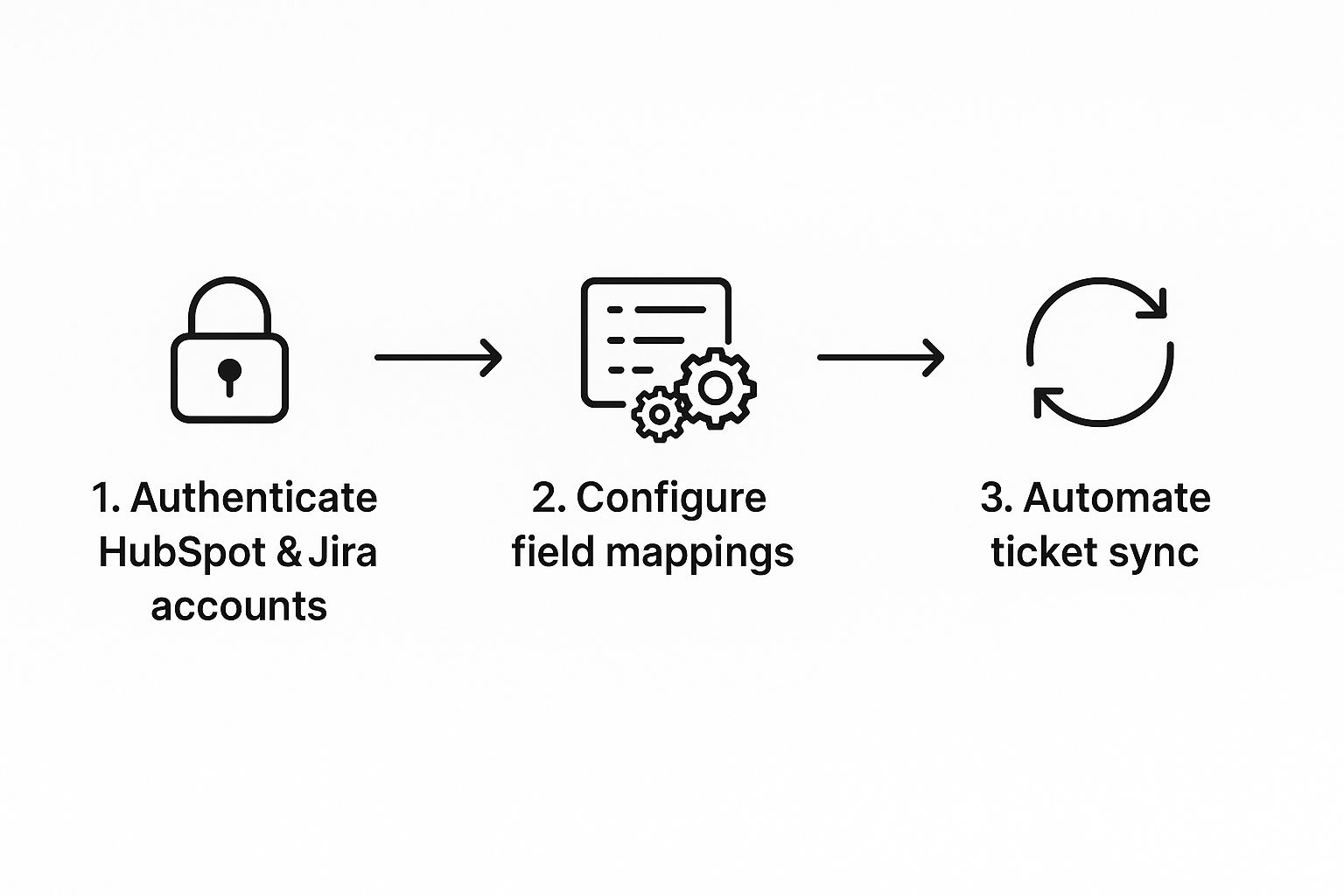Breaking Down Silos: Why HubSpot Jira Integration Matters
Are you tired of the frustration caused by your customer service team residing in HubSpot while your developers work in Jira? This disconnect can create significant information gaps that negatively impact your customers. Important customer context gets lost in translation, slowing down resolution times, causing miscommunication, and ultimately affecting customer satisfaction. Effective communication is essential for any successful business, and a fragmented workflow can undermine that very foundation.
This section explores how HubSpot Jira integration bridges these disconnected worlds, enabling seamless data flow and transforming team collaboration. This integration empowers teams to work smarter, not harder. Imagine your support team instantly creating actionable Jira tickets directly from HubSpot, complete with all the relevant customer information. At the same time, developers can access vital customer context within Jira, gaining a deeper understanding of how their work impacts real people.

This connection goes beyond simply reducing manual data entry; it fundamentally changes visibility across departments. It creates a unified view of the customer issue lifecycle accessible to everyone. This increased transparency fosters accountability and empowers teams to proactively address customer needs, leading to faster resolutions and increased customer satisfaction.
The Growing Importance of Integration
The integration of HubSpot and Jira has become increasingly important, particularly for streamlining workflows and enhancing customer-centric approaches. Syncing customer data allows companies to effectively track customer preferences, pain points, and feature requests. This, in turn, leads to improved product development and higher customer satisfaction. As of 2022, this type of integration has been a priority for corporations seeking to improve operational efficiency and customer experience. Learn more about this trend here.
HubSpot Jira integration also significantly improves collaboration by streamlining information sharing. Teams have the information they need at their fingertips, eliminating the need to search through emails or switch between platforms. This reduces errors, improves communication efficiency, and frees up valuable time to focus on delivering exceptional customer experiences. This also fosters a more collaborative environment where everyone works together towards a common goal: customer success.
The Hidden Costs of Disconnected Systems

Disconnected systems can create a chain reaction of problems, especially for critical platforms like HubSpot and Jira. Without a HubSpot Jira integration, vital customer information often gets lost, leading to negative consequences that can damage your brand and hinder growth.
The Consequences of Miscommunication
One of the most significant hidden costs is miscommunication due to siloed information. When customer issues are manually relayed between HubSpot and Jira, crucial context can disappear. This often leads to developers misunderstanding customer needs and building incorrect solutions. The result? Frustrated customers and wasted development time.
Manual data entry between systems is also incredibly time-consuming. Support teams waste valuable time copying and pasting information, instead of directly assisting customers. This manual process also introduces human error, risking data integrity and potentially leading to inaccurate reporting and analysis.
Accountability and Lost Opportunities
Another significant cost is the lack of clear accountability. With disconnected systems, tracking the progress of customer issues becomes difficult. This makes it challenging to provide customers with accurate updates, further eroding their trust.
Having no single source of truth makes it hard to pinpoint areas for improvement and optimize workflows. Valuable customer feedback insights can be completely missed. When data is siloed, organizations can't identify patterns in customer issues that could be used for product development. This missed opportunity hinders innovation and prevents companies from building products that truly meet customer needs.
To further illustrate the negative impact of disconnected systems, let's take a closer look at a comparison table. This table highlights the specific challenges, business impact, and root causes stemming from operating HubSpot and Jira in isolation.
The Business Impact of Disconnected Systems
This table illustrates the measurable consequences organizations face when HubSpot and Jira operate as separate islands, highlighting the financial, operational, and customer experience impacts.
| Challenge | Business Impact | Root Cause |
|---|---|---|
| Lost Customer Information | Decreased customer satisfaction, potential churn | Manual data transfer between HubSpot and Jira |
| Miscommunication Between Teams | Wasted development time, incorrect solutions built | Lack of shared context around customer issues |
| Inefficient Workflows | Increased support team workload, slower response times | Manual data entry and updates |
| Difficulty Tracking Issues | Inability to provide timely updates to customers, further frustration | No single source of truth for customer issue tracking |
| Missed Opportunities for Improvement | Inability to identify trends in customer issues, hindered product development | Siloed data prevents pattern recognition |
As the table clearly demonstrates, disconnected systems lead to a variety of negative outcomes. These range from frustrated customers and inefficient processes to missed opportunities for innovation and growth.
Ultimately, a HubSpot Jira integration isn't just a technical fix; it's a strategic investment in customer success and business growth. Connecting these systems empowers organizations to work smarter, not harder. It improves customer satisfaction and unlocks an organization's full potential.
Building Your Integration: A Practical Implementation Guide
Ready to connect your HubSpot and Jira platforms? This guide walks you through the integration process, from initial setup to more advanced configurations. We'll simplify the steps involved, ensuring a smooth and successful HubSpot Jira integration.
Getting Started: Permissions and Requirements
Before you begin, ensure you have the right permissions. You'll need super admin or App Marketplace permissions in your HubSpot account. You'll also need a Jira Cloud account. This sets the stage for a secure and efficient connection.
Step-by-Step Implementation
These steps outline the core process for integrating HubSpot and Jira:
- Locate the Jira Integration: Navigate to the App Marketplace in your HubSpot account and search for "Jira".
- Install the App: Click "Install app" when you find it and review the permissions. Accepting these grants the necessary access for data synchronization.
- Authenticate Your Accounts: Follow the prompts to connect your HubSpot and Jira accounts. This creates the foundation for a seamless data flow.
- Configure Field Mappings: Map corresponding fields between the two platforms. This ensures the correct data flows to the right place, providing valuable context for both teams. Think about which data points are most important for your developers to understand the customer.
- Automate Ticket Sync: Set up automated ticket synchronization to improve workflows and avoid manual data entry. This ensures both platforms stay updated.
The following infographic illustrates the key integration steps:

The process flows logically from authentication to field mapping and finally, automated ticket synchronization. This structured approach creates a robust and effective HubSpot Jira integration. This setup allows teams to quickly benefit from a connected system. The Jira app, available with any HubSpot subscription, is set up within the HubSpot marketplace and requires a Jira Cloud account. Learn more about setup and implementation here.
Field Mapping Best Practices
Effective field mapping is essential for a successful integration. Focus on mapping customer data that provides context for your development teams. Examples include customer pain points, requested features, and important account details. Also, consider mapping custom properties specific to your business for comprehensive data transfer.
Troubleshooting Common Challenges
Occasionally, you might encounter issues. Common problems include permission conflicts, field mapping errors, and authentication issues. Most of these are easily solved. Double-checking permissions, verifying field mappings, and confirming authentication credentials usually fixes most issues. For complex problems, consult the documentation or contact support for assistance. These steps will help ensure your HubSpot Jira integration is properly set up and working as expected.
Transformative Features That Change How Teams Work
Integrating HubSpot with Jira can significantly improve teamwork. It's more than just connecting two platforms; it's about transforming how teams interact. This integration offers powerful features that fundamentally change how customer support, sales, and development teams collaborate.
One key feature is two-way synchronization. This ensures that everyone works with the most up-to-date information, whether they're in HubSpot or Jira. This eliminates confusion and delays caused by outdated data, keeping all teams aligned and informed.
Automation For Efficiency
Automation is another impactful feature. Automatic ticket creation transforms incoming customer issues into actionable Jira tasks, removing manual data entry and reducing errors. This frees up support teams to focus on helping customers, not managing tickets. Developers also benefit by receiving all the relevant context directly within Jira, allowing them to address issues quickly.
Context Is Key: The Contact/Company Panel
The contact/company panel in Jira provides developers with crucial customer context, something often missing in traditional workflows. This panel displays relevant HubSpot data directly within Jira, including customer history, communication preferences, and past interactions. Having this information readily available empowers developers to create personalized solutions, leading to greater customer satisfaction and stronger relationships. Many digital marketing tools can further assist in various aspects of integrating HubSpot and Jira.
Seamless Communication: Comment Mirroring
Comment mirroring ensures that all communication about an issue is visible in both HubSpot and Jira. This breaks down information silos and ensures everyone is on the same page. This real-time communication flow minimizes delays and prevents crucial updates from being missed. The HubSpot Integration for Jira (Bi-directional Issue Sync) highlights the growing demand for seamless platform integration with over 203 installations. This integration also supports both Jira Cloud and Data Center. More detailed statistics are available here.
To help you understand the different integration options, we've compiled a comparison table:
HubSpot Jira Integration Options Compared
This comparison evaluates the capabilities, limitations, and implementation considerations for different HubSpot Jira integration approaches available to your organization.
| Feature | Native Integration | Third-Party Solution | Custom API Integration |
|---|---|---|---|
| Two-way Synchronization | Limited | Dependent on the Solution | Customizable |
| Automatic Ticket Creation | Basic | Advanced features often available | Fully Customizable |
| Contact/Company Panel | Basic Information | Varies based on the solution | Customizable data display |
| Comment Mirroring | Limited | Offered by several solutions | Fully Customizable |
This table summarizes the key differences between native integrations, third-party solutions, and custom API integrations for connecting HubSpot and Jira. Choosing the right approach depends on your specific needs and technical capabilities.
By implementing these features, businesses can significantly improve workflows, enhance collaboration, and create exceptional customer experiences. Integrating HubSpot and Jira streamlines communication, breaks down silos, and allows teams to work more efficiently. This fosters a more unified, customer-centric approach that drives both customer satisfaction and business growth.
From Frustration to Flow: A Customer Support Transformation

Dataflow Solutions, a growing tech company, faced a common challenge. Their customer support team relied on HubSpot for daily operations, while their developers primarily used Jira. This disconnect created frustration and inefficiencies, hindering both teams. Support struggled to provide timely updates on bug fixes, impacting customer satisfaction. Developers, on the other hand, lacked crucial context regarding the impact of their work on actual customers, making prioritization difficult. The lack of a strong HubSpot Jira integration was affecting their bottom line.
Bridging the Gap: The HubSpot for Jira Implementation
To address this issue, Dataflow Solutions implemented the HubSpot for Jira app. Initially, there was internal resistance. Support agents worried about the learning curve of a new system. Developers questioned the value it would bring.
However, after targeted training and clear communication highlighting the integration's benefits, the tide began to turn. Both teams began to recognize the potential for improved collaboration and efficiency. The implementation was strategic, starting with careful field mapping between the two platforms.
This ensured that essential customer information, such as account details and problem descriptions, flowed seamlessly between HubSpot and Jira. The focus then shifted to automating ticket creation and mirroring comments between the systems.
Reaping the Rewards: Measurable Improvements
The results were striking. Dataflow Solutions saw their average resolution time decrease significantly, from 9.2 days to 5.5 days. Duplicate tickets, a constant source of frustration, plummeted by 67%. And most importantly, customer satisfaction scores jumped by 23 points.
These improvements weren't just about the numbers. The integration fundamentally changed how the teams interacted. Support agents gained visibility into the development process, enabling them to provide more accurate and timely updates. Developers, armed with richer customer context, were able to create more effective and impactful solutions.
A Team Transformed
The change resonated deeply within the teams. "Before the integration, it felt like we were constantly chasing the development team for updates," a Dataflow Solutions support agent shared. "Now, we have the information we need readily available."
A developer echoed this sentiment, adding, "Having access to the customer's HubSpot information directly in Jira gives us so much more context. We can truly understand the real-world impact of the issues we’re fixing."
Dataflow Solutions’ story showcases the transformative potential of the HubSpot Jira integration. It’s not simply about connecting systems; it's about fostering collaboration, enhancing customer experience, and ultimately, driving business growth. They opted for resolution Reichert Network Solutions GmbH's HubSpot for Jira app to tackle this challenge. This app delivers crucial features such as two-way field synchronization and automated ticket creation, which are vital for smooth data flow and efficient teamwork.
Maximizing Value: Strategic Best Practices
Implementing a HubSpot Jira integration is just the first step. Truly maximizing its value requires a strategic approach. This involves optimizing workflows, refining field mappings, and encouraging team adoption. Let's explore how to extract the most from your HubSpot Jira connection.
Designing Efficient Workflows
Effective workflow design ensures issues move seamlessly through your system, minimizing bottlenecks and maximizing efficiency. Start by clearly defining the stages an issue progresses through, from initial reporting in HubSpot to resolution in Jira.
For example, a workflow might include stages like "New," "In Progress," "Testing," and "Resolved." Each stage should trigger automatic actions, such as notifications to relevant team members or updates to linked records. This automation keeps everyone informed and the process moving forward.
Strategic Field Mapping: Providing Essential Context
Mapping the right fields between HubSpot and Jira ensures developers have the essential context they need to address customer issues effectively. This goes beyond basic contact details.
Consider which customer data provides the most context. This might include customer pain points, specific feature requests, or relevant account details. Also, map custom properties unique to your business, ensuring comprehensive data transfer. This empowers developers with valuable insights to create targeted solutions.
Empowering Teams Through Training and Documentation
Successful integration hinges on team adoption. Comprehensive training is essential to equip teams with the skills and knowledge they need. Training should cover everything from basic navigation to advanced features like two-way synchronization and automatic ticket creation.
Clear documentation, including step-by-step guides and troubleshooting tips, is also crucial. This documentation should be easily accessible and regularly updated to reflect any changes to the integration. This investment minimizes resistance to change and empowers teams to fully utilize the integration.
Transforming Data Into Insights: Strategic Tagging and Categorization
Use your HubSpot Jira integration to gather valuable insights. By strategically tagging and categorizing issues, you can identify patterns and trends that inform product development and customer support strategies.
For example, tagging tickets by product area or feature request can reveal recurring customer pain points. This data-driven approach allows you to address the root causes of recurring issues, prioritize feature requests, and create a more customer-centric product roadmap, ultimately leading to higher customer satisfaction.
Your HubSpot Jira Integration Questions Answered
Integrating HubSpot and Jira can bring up some important questions. You might be wondering about security, if your systems are compatible, the cost, and whether it can scale with your business. This section addresses those common concerns to provide clarity and guidance for a successful integration.
Security and Data Handling
One of the first things people think about is the security of sensitive customer data. The HubSpot Jira integration prioritizes data protection by using robust encryption and secure data transfer protocols. Access is also carefully controlled, using permissions to make sure only authorized personnel can see and modify data. This helps maintain confidentiality and data integrity.
Compatibility and System Requirements
For a smooth integration, you'll want to ensure your HubSpot and Jira versions are compatible. The integration generally works with a range of versions for both platforms. However, some features may have limitations with older systems. Checking the integration documentation or contacting support can help confirm compatibility and any potential issues. For general information about starting a blog, you can check out this WordPress resource.
Pricing and Integration Options
The right integration solution depends on your budget and what you need it to do. There are several pricing models, ranging from free native marketplace integrations with basic features to paid third-party solutions with more advanced capabilities. For very specific requirements, custom API development is also a possibility, though this usually means higher initial costs and ongoing maintenance.
Performance and Scalability
If your organization deals with a high volume of tickets, performance and scalability are crucial. A well-designed HubSpot Jira integration can effectively manage large amounts of data, minimizing delays and ensuring smooth operations even under pressure. Features like optimized data synchronization and automated workflows can also improve performance and reduce the impact on your system's resources.
Customization and Flexibility
Businesses with unique workflows will appreciate the integration’s customization options. The HubSpot Jira integration can be adapted to specific business processes. You can map custom fields and automate specific actions without negatively impacting performance. This flexibility ensures the integration fits your needs, optimizing efficiency across your organization.
Ready to improve your workflows and collaboration? Try HubSpot for Jira free today and see the benefits of a unified platform. Start your free trial of HubSpot for Jira now!
